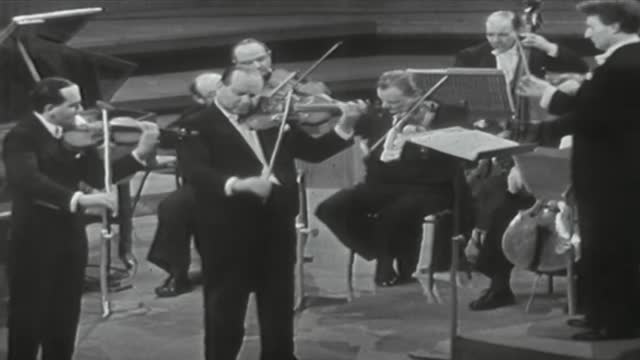It is sometimes said that Igor Oistrakh’s playing is weaker than his father’s and his artistic approach more objective. Conversely there were sometimes disagreements when Igor was soloist under David’s baton, Igor seeking a more emotive approach than his father. Whatever the differences, their twenty-seven years of collaboration produced some fascinating and compelling performances.
Oistrakh speaks of his determined haste, after a lazy start to his studies, to catch up with his fellow students at the Moscow Conservatory in a culture that prized precociousness. This he holds to be an advantage ultimately, giving him a formidable grasp of technique.
Perhaps because of his father’s connections Igor was able to work closely with the foremost senior Soviet composers such as Kabalevsky, Prokofiev and Shostakovich. He considers the recording process both a boon and a nuisance, but aims to ‘recreate enthusiasm and freshness, artificially’. Indeed, he has been a prolific recording artist in a career that also encompasses teaching and judging prestigious competitions.
On record and on film he is a cool, disciplined artist. Comparison with his father is not always totally favourable for Igor—in a 1957 Bach Double Concerto, for example, he sounds appreciably the more distant, with a leaner tone and less compelling contact with the string. Their 1972 Mozart Sinfonia concertante, however, in which David plays the viola and directs, is evenly weighted with power and delicacy in equal measure.
In solo repertoire Igor certainly holds his own. His recording of Brahms’s Op. 108 from 1962, with his wife at the piano, takes a middle-of-the-road interpretative approach free of excess mannerism, and the depth of his G-string sound rather confounds criticism of him as the weaker Oistrakh. A classical bias emerges in works such as Mendelssohn’s Concerto; here his fine 1955 performance avoids the maudlin pace of the slow movement so frequently heard at this time and evidences tidiness and fleetness of execution. The same can be said of his Suite Italienne, in which Stravinsky’s neo-classical style is captured with depth and assertiveness, but has also a poised balance that suits the work. Oistrakh can also produce considerable power. Wieniawski’s Concerto No. 2 (c.1955) is impressive and absolutely accurate.
© Naxos Rights International Ltd. — David Milsom (A–Z of String Players, Naxos 8.558081-84)
| Title | |
| BACH, J.S.: Concerto for 2 Violins / MOZART, W.A.: Sinfonia concertante / BRAHMS, J.: Violin Concerto (D. and I. Oistrakh) | |

|
BACH, J.S.: Concerto for 2 Violins / MOZART, W.A.: Sinfonia concertante / BRAHMS, J.: Violin Concerto (D. and I. Oistrakh)
Composers:
Bach, Johann Sebastian -- Brahms, Johannes -- Mozart, Wolfgang Amadeus
Artists:
Davis, Colin -- English Chamber Orchestra -- Kondrashin, Kirill -- Menuhin, Yehudi -- Moscow Philharmonic Orchestra -- Oistrakh, David -- Oistrakh, Igor
Label/Producer: ICA Classics |
